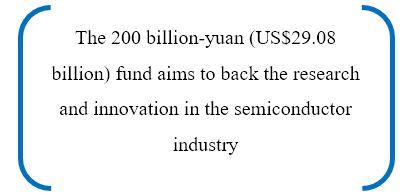Megha Pardhi

Source: Marketwatch.com
Even as scientists call for a Marshall Plan to preserve US dominance in computing power, its technology war might have turbocharged China’s ambitions instead of scuttling them. The Communist Party has responded to America’s ‘decoupling’ strategy with a clarion call for self-reliance while using post-COVID19 recovery efforts to galvanize its entrepreneurs, researchers and even retail investors. Recent developments in China’s semiconductor industry indicate that progress there might serve as a playbook in the future for other segments of the technology world.

Semiconductors form the backbone of high technology used to make integrated circuits (IC) (chips) for use in electronic gadgets ranging from digital clocks to avionics. The current crop of chip industry leaders hail from US, Europe, Taiwan, and South Korea. China’s ambitions to dominate this industry are not a secret but despite a plethora of State-led policy measures such as special funds, tax incentives and even alleged espionage, Chinese companies are nowhere close to their foreign peers.
Focused support for the semiconductor industry can be traced back to 2014 when China released the National Semiconductor Industry Development Guidelines and set up the China National Integrated Circuit Industry Investment Fund. This 200 billion-yuan (US$29.08 billion) fund aims to back the research and innovation in the semiconductor industry. Moreover, the semiconductor industry in one of the ten sectors prioritized under ‘Made in China 2025′ initiative.

A new policy introduced by the State Council in August 2020 exempts corporate income tax on enterprises based on specified criteria. For example, integrated circuit (IC) projects and enterprises that have operated for more than 15 years will be exempted from corporate income tax for up to 10 years if they employ the 28-nanometre processor or more advanced nodes, while projects from 65nm to 28nm will get five years tax-free and qualify for a 50 per cent discount on the corporate rate for the subsequent five years. The ‘thousand talents program’ of China aims to attract Chinese diaspora in high technology areas, including AI and semiconductors. According to a study by MacroPolo, China still lags significantly behind the US in terms of expertise in AI. While 29 per cent of global AI researchers hail from China, only 11 percent of them work in China. On the other hand, 59 per cent of AI researchers work in the US. With the ‘thousand talents program’ and other similar initiatives, China aims to bridge this gap. Despite setbacks due to COVID19 and trade war with the US, China has persisted with its efforts to develop chip manufacturing capabilities. In September 2020, China included the third-generation semiconductor industry into China’s upcoming 14th Five-Year Plan (2021-25). The details of this policy are still unknown and likely to be available after October 2020.
In addition to State agencies, the Chinese private sector has also played a crucial role in furthering the chip self-sufficiency ambitions of China. First, the private sector has been vital in acquiring key strategic semiconductor technologies and companies. For example, a recent Reuters report unearthed an extraordinarily complex series of transactions which landed Microprocessor without Interlocked Pipelined Stages (MIPS), a leading US chip technology, in the portfolio of China registered CIP United. Second, the private sector in China is also engaged in research and development of advanced semiconductor technologies. Huawei’s fabless IC company Hisilicon is currently one of the most advanced IC companies in China. Chinese tech giants like Alibaba and Baidu also have their semiconductor chips design companies. Moreover, numerous startups in China focus on semiconductors. Some of the top startups in China are CXMT, Senscomm, Yangtze Memory Technologies, ProPlus Electronics, Spectrum Materials, and ASR Microelectronics.

The culmination of all these efforts is that China’s semiconductor industry is slowly inching forward despite challenges posed by trade war and COVID19. Self-sufficiency in funding is perhaps easiest to achieve. Semiconductor Manufacturing International Corporation (SMIC), a Chinese foundry with government stakes, was recently listed on Shanghai STAR stock exchange after delisting in the US. The listing received fast-track approval within a record 19 days and SMIC shares gained 245% on the first day of listing. This offering made STAR the exchange with the second-most funds raised in the world in 2020, behind Nasdaq and ahead of Hong Kong.
Several challenges plague China’s ambitions to become self-sufficient in semiconductor design and manufacturing. First, the COVID19 has affected several industries including semiconductor manufacturing. The semiconductor chip manufacturing industry is one of the truly global industries with the operations spread out across several locations. The COVID19 situation has affected the global supply chains and in turn, the semiconductor industry in China. Despite the COVID19, market sentiment in China’s semiconductor manufacturing remained positive. Second, the poor planning can likely be an obstruction in achieving the Chinese dreams of self-sufficiency in manufacturing. For example, reports have emerged of a US$20 billion government-backed state-of-the-art semiconductor manufacturing plant in Wuhan being stalled due to poor planning and lack of funding. Another US$3 billion government-backed chip plant owned by Tacoma Nanjing Semiconductor Technology was reported for going bankrupt. Third, the semiconductor industry in China is generations behind the top manufacturers in the field. SMIC has just started mass production of 14nm 1st generation FinFET technology ICs while world’s largest semiconductor foundry Taiwan Semiconductor Manufacturing Co. (TSMC) is moving towards manufacturing 5nm technology. Moreover, as per the SCMP China Internet Report 2020, China still lacks 20 key technical materials and 30 advanced technology processes. China plans to overcome this technological gap by concentrating on ‘AI chips’. AI chips are specialized chips optimized for Artificial Intelligence computations. The limitations of chip design, as postulated by Moore’s law, are making it difficult for chip makers to design and manufacture cost-effective chips. AI chips can be manufactured using relatively older technology and are comparable in terms of performance. AI chips have low barriers to entry as compared to the traditional chips. Hence, it is easier for startups to enter the chip industry. Third, the US-China Trade War has severely hampered China’s plans. However, Chinese government and private industry are determined to counter the loss due to this trade war. For example, gauging the difficulties caused due to the US-China Trade War, China’s tech veterans have launched a fund to support the Chinese tech companies sanctioned by the US.
These technological and political obstacles will at most delay China’s goals but are unlikely to halt them. If recent trends in China’s semiconductor industry gain momentum, they are likely to form part of a template of the high-tech industry seeking self-sufficiency.